

Alternanthera reineckii ''roseafolia'' Common Name: Magenta Water HedgeNative to: South American Amazon regionHeight: 10 to 20 inchesWidth: 4 to 6 inches, based on leaf growthGrowth Rate: SlowPlacement: Mid to BackgroundLighting Needs: Moderate to high (2-4 watts)Temperature: 75 to 80.6 degreesHardness: Does best in soft, slightly acidic waterDifficulty: Relatively easy The purple colour underneath Alternanthera reineckii ''roseafolia'' leaves provides an effective contrast to the many green aquarium plants in an aquarium - particularly when planted in groups.
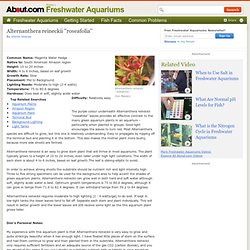
Good light encourages the leaves to turn red. Most Alternanthera species are difficult to grow, but this one is relatively undemanding. Easy to propagate by nipping off the terminal bud and planting it in the bottom. This also makes the mother plant more bushy, because more side shoots are formed. Www.aquaticplantcentral.com/forumapc/plantfinder/details.php?id=136. Cyperus helferi is one of the few plants in its genus that can adapt to submersed life.
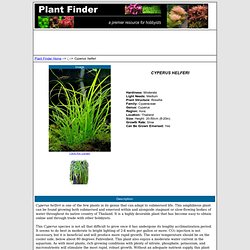
This amphibious plant can be found growing both submersed and emersed within and alongside stagnant or slow-flowing bodies of water throughout its native country of Thailand. It is a highly desirable plant that has become easy to obtain online and through trade with other hobbyists. This Cyperus species is not all that difficult to grow once it has undergone its lengthy acclimatization period. It seems to do best in moderate to bright lighting of 2-4 watts per gallon or more. CO2 injection is not necessary, but it is beneficial and will produce more rapid growth. C. helferi produces long, flowing leaves that arc elegantly across the water column.
This elegant plant is best used as a focal point in the midground or as a background accent. Photo #1: Submersed US and International Copyright 2004 by Tula Top All Rights Reserved. Rotala rotundifolia. Echinodorus bleheri. Echinodorus bleheri is commonly known as Amazon sword plant, although other plants are also known under this common name.

The aquatic plant is cultivated for and used in freshwater aquariums. Synonyms[edit] Keeping Aquarium Plants. Is keeping aquarium plants hard?
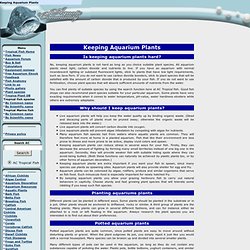
No, keeping aquarium plants is not hard as long as you choice suitable plant species. All aquarium plants need light, carbon dioxide and nutrients to live. If you have an aquarium with normal incandescent lighting or subdued fluorescent lights, stick to plants that have low light requirements, such as Java Fern. If you do not want to use carbon dioxide boosters, stick to plant species that will be satisfied with the amount of carbon dioxide that is produced by your fish. If you do not want to use fertilization, choose plant species that will absorb sufficient amounts of nutrients from the water.
You can find plenty of suitable species by using the search function here at AC Tropical fish. Guidelines to Add Plants in Aquarium. Prior to putting new plants into your tank just make certain that they're clean and totally free from germs and unwanted snails.

To do this, rinse them under the tap and remove any yellow or decaying leaves, and also remove any of the jellylike eggs of snails you might find on the leaves. They can then be immersed in a solution of concentrated lime water diluted with water to a proportion of six parts tap water to one component lime water. To make lime water, liberally mix hydrated lime in water and let the sediment settle, then draw off the clear water and mix as previously described. The plants should be left in the solution for 10 minutes, no more, and then placed in a solution of permanganate of potash for a like period. The strength of the potash should be a quarter grain to a gallon.
Planting Techniques - Part 1. Choosing Substrate When planting an aquarium one has to take into account many factors to successfully plan your planting arrangement.
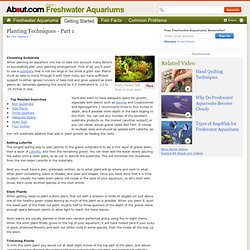
First of all, you'll want to use a substrate that is not too large or too small a grain size. Plants must be able to move through it with their roots, but have sufficient support to either spread runners or take root and grow upward as stem plants do. Generally speaking this would be 3-5 millimeters or .12 to .20 inches in size. You'll also want to have adequate space for growth, especially with plants such as Swords and Cryptocornes and Aponogetons.
I recommend three to four inches in depth, and if possible more depth in the back sloping to the front. Adding Laterite The longest lasting way to add Laterite to the gravel substrate is to lay a thin layer of gravel down, then a layer of Laterite, and then the remaining gravel. Aquarium Plants. 3.
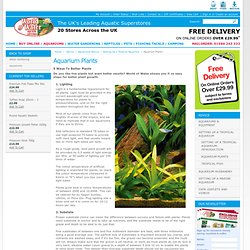
Substrate Fertiliser Once gravel has been chosen, a fertiliser must be added to provide the plants with their food. As good as any sand, gravel or grit is, they are mostly sterile so they need a substrate fertiliser in order to allow the plants to take up nutrients. Some very hardy plants like Egeria take nutrients from the water and will survive in sterile substrates, but most aquatic plants like Vallisneria, Amazon Sword plants and Cryptocoryne need food. Compare your substrate and plants to those in your garden. Special aquatic soils, eg Tetra Complete Substrate, are available from World of Water along with fertiliser tablets and powders to make sure you achieve good results. There is another element that aids growth of aquatic plants. A heating cable is a low-wattage cable that is placed under the gravel, amongst the fertiliser or soil. Heating cables are not essential, but they have been the key to success in many Dutch-style planted aquariums for the past few decades.
Eichinodorus species "red"